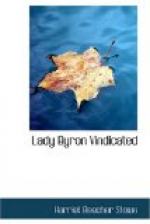aberration can, in this case, be for a moment maintained.
If Lady Byron’s statement of facts to Mrs. B.
Stowe is to be viewed as the creation of a distempered
fancy, a delusion or hallucination of an insane mind,
what part of the narrative are we to draw the boundary-line
between fact and delusion, sanity and insanity?
Where are we to fix the point d’appui of the
lunacy? Again: is the alleged ‘hallucination’
to be considered as strictly confined to the idea
that Lord Byron had committed the frightful sin of
incest? or is the whole of the ‘True Story’
of her married life, as reproduced with such terrible
minuteness by Mrs. Beecher Stowe, to be viewed as the
delusion of a disordered fancy? If Lady Byron
was the subject of an ‘hallucination’
with regard to her husband, I think it not unreasonable
to conclude that the mental alienation existed on the
day of her marriage. If this proposition be
accepted, the natural inference will be, that the
details of the conversation which Lady Byron represents
to have occurred between herself and Lord Byron as
soon as they entered the carriage never took place.
Lord Byron is said to have remarked to Lady Byron,
’You might have prevented this (or words to this
effect): you will now find that you have married
a devil. Is this alleged conversation to be
viewed as fact, or fiction? evidence of sanity, or
insanity? Is the revelation which Lord Byron
is said to have made to his wife of his ‘incestuous
passion’ another delusion, having no foundation
except in his wife’s disordered imagination?
Are his alleged attempts to justify to Lady Byron’s
mind the morale of the plea of ’Continental latitude—the
good-humoured marriage, in which complaisant couples
mutually agree to form the cloak for each other’s
infidelities,’—another morbid perversion
of her imagination? Did this conversation ever
take place? It will be difficult to separate
one part of the ‘True Story’ from another,
and maintain that this portion indicates insanity,
and that portion represents sanity. If we accept
the hypothesis of hallucination, we are bound to view
the whole of Lady Byron’s conversations with
Mrs. B. Stowe, and the written statement laid before
her, as the wild and incoherent representations of
a lunatic. On the day when Lady Byron parted
from her husband, did she enter his private room,
and find him with the ’object of his guilty
passion?’ and did he say, as they parted, ’When
shall we three meet again?’ Is this to be considered
as an actual occurrence, or as another form of hallucination?
It is quite inconsistent with the theory of Lady
Byron’s insanity to imagine that her delusion
was restricted to the idea of his having committed
‘incest.’ In common fairness, we
are bound to view the aggregate mental phenomena which
she exhibited from the day of the marriage to their
final separation and her death. No person practically
acquainted with the true characteristics of insanity
would affirm, that, had this idea of ‘incest’




